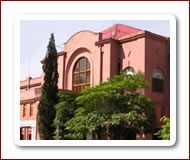| Advisory Services |
Dill Seeds
BOTANICAL NAME:
FAMILY:
SYNONYM(S):
- Anethum sowa
- Anethum gnaveolens
URDU NAME:
REGIONAL NAME:
- Bengali: Sowa, Sulpa
- Persian: Shot
- Hindi: Sowa
- Pashto: Soya
- Sanskrit: Satappushpi
- Sindhi: Sadakuppa, Sawa
- Arabic: Shubith
- Punjabi: Soya
UNANI/TIBBI NAME:
ENGLISH NAME:
- Indian Dill, Pakistani Dill, Dill Seeds
HABITAT:
- It is widely cultivated throughout Pakistan, Punjab, NWFP, Baluchistan & Gilgat
DESCRIPTION:
An annual herb which grows to height from 60-80 cm
- Leaves linear, 2-3 pinnate
- Stem smooth, shiny and hollow
- Flat terminal umbel with numerous flowers
- Fruits oval, flat, convex, narrowly winged, light brown in colour, 2mm wide with three longitudinal ridged and vittae
PART USED:
TASTE:
TEMPERAMENT:
PERIOD OF OCCURRENCE:
- It is cultivated as a cold weather crop. Flowers in springs
PROCEDURE & TIME OF COLLECTION:
- Seeds ripen in autumn. Cutting is done in the early morning on late evening with cane to prevent seeds loss by shaking. Seeds are dried
CONSTITUENTS:
- D-cavone
- D-limonene
- Dill-apiol
- Anethol
- Anisaldehyde
- Euginol
- Hymol
- Calcium
- Phosphorous
- Iron magnesium, sodium
- Potassium
- Zinc
SUBSTITUTES:
- Saunf/fennels (foeniculum vulgare)
ACTIONS AND USES IN UNANI SYSTEM OF MEDICINE:
Pharmacological action:
- Carminative
- Aromatic
- Stomachic
- Diuretic
- Stimulant
- Resolvent
- Glactogogue
- Antidysentric
Therapeutic uses:
- Relieves gripping
- Flatulence
- Colic and abdominal pains
- Cold
- Hiccough
- Ear ache
- In problems of liver
- Spleen
- Bladder
- Chest
- Kidney
- Useful in piles
DOSES:
CORRECTIVES:
IMPORTANT UNANI FORMULATIONS:
- Jawanish zaruni sada
- Malun nankhwah mushki
- Majun munraweh-ul-arwah
- Labub-ul-asran
ASTROLOGY:
|
|




